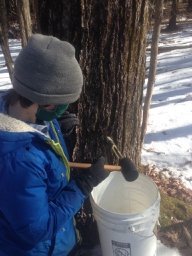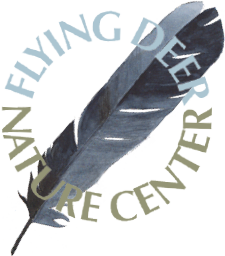Our Wild Ways reunion today was so sweet. As folks trickled in and said their hellos, they inspected the beauty of a recently found dead fox, admiring its coat and heavily furred paws and discussing its lifeways. There was also a station to experiment with the process of turning stones into usable sharp cutting tools, one of humankind’s oldest crafts, which were later used in our craft of the day—Maple Spiles.
We circled together in the crisp morning air, oriented to the Spring Semester ahead, played a game, and went over our agreements—the rules of conduct, culture, and care that we all work to uphold. A Raven and a Red-shouldered Hawk graced our circle as they flew overhead. We later saw a Bald Eagle, and Mary pointed out that the Spring migration is evidently upon us. It won’t be too long before more Spring arrivals start filling the air with their songs!
Another big event right now is the Sugar Maple sap flow. We seized upon this short-lived event today, highlighting the various animals that also enjoy the Sugaring season: Red Squirrels, Yellow-bellied Sapsuckers, and even other animals like Chickadees that have been spotted drinking sap off of Sugar Maple icicles recently! Students in both groups—after getting acquainted, cleaning up camp and digging into various camp chores—quested for materials to make their own Maple spiles, crossing frozen creeks and searching for a woody species of shrub that has a large diameter pithy center that is easily burned or bored out to produce a very functional Maple spile—the Staghorn Sumac. Along the way, we found recent Otter scat, an indication that our waterways are healthy and full of fish! There was a pit stop at a rope swing that swung us out over a frozen pond to go slipping around on the ice!

Around a campfire, sections of Sumac were carefully notched and tapered, then snapped in two to produce two separate spiles. A metal rod was then heated up to bore out the pithy inside of the trunk. We were then ready to tap! Each group successfully tapped a few Maple trees which will contribute to our big boil next week. Many teens went home with spiles to be used for tapping trees at home, to bring in buckets or jugs of sap next week for our annual Maple Fest! If you are new to this, grab a drill with a large drill bit that is only slightly larger than the smallest tapered end of the spile. Find a Sugar Maple or Red Maple, even a Birch, and drill a slightly upward hole about 1.5 inches into the tree, in a location that you are able to place a bucket directly below.
In Good Nature,
Josh, and the FDNC Staff—Raven, Alana, Mary, and Raei, March 8, 2021
